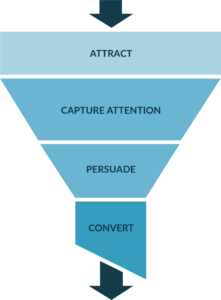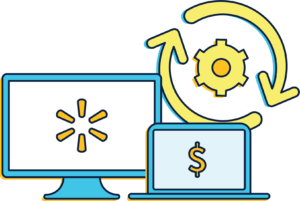Provider Spotlight features tips for success from etailz
We’re pleased to introduce a new partner in our Provider Spotlight this month. etailz is a full-service provider offering a variety of software and services for online retail. Read on for insights from their broad experience supporting eCommerce businesses as they pursue a variety of goals. Not yet a seller on Walmart Marketplace? Apply today to get started!
New year, new strategy

You might already have your online seller strategy locked in, but it’s no secret that different marketplaces require different strategies. As Walmart’s market share continues to grow in the online retail space, it’s important to get ahead of the game.
In this post, we’ll discuss five of the most common business goals and share key considerations and advice for achieving each of them on Walmart Marketplace.
The five goals we’ll examine:
- Expanding to a new marketplace
- Protecting your brand presence
- Converting more customers
- Launching new products
- Scaling your marketplace business
etailz offers bundled solutions for each of these goals. Each solution contains a set of our proprietary software and proven services that are designed to rapidly and effectively achieve each of these goals. If you find something you like, get in touch with us!
#1 Expanding to a new marketplace
Expanding to a new marketplace is an exciting and daunting endeavor. One of the first and most important decisions you’ll have to make is how to run your distribution and fulfillment. In the case of Walmart, sellers will need to either utilize their own warehousing solutions or partner with a dedicated fulfillment service, such as Deliverr.

Logistics
If you choose to work with a fulfillment partner, do your research. There are several major players in this field right now. When assessing them, consider the following questions.
Questions to ask a logistics provider
Warehouses
How many warehouses do they have and where they are located? Quantity, size, and location of warehouses will impact your shipping and storage costs.
Speed
Can they provide 1-day or 2-day shipping? Data proves that convenience is the name of the game for online retail. Shoppers expect to receive packages quickly, so if your rival offers a similar product with faster shipping, chances are, you’ll lose the sale.
Packaging
Do they offer intelligent packaging solutions? Are they able to package your products in the smallest, most secure box, bag, or envelope possible? The larger the box, the greater the storage and shipping fees. It’s pennies on the dollar, but as your volume grows, those pennies can quickly add up.
In addition, intelligent packaging can reduce your return rate due to damages en route: a product is less likely to be damaged in an appropriately sized box than in one that is either oversized or undersized.
Returns
Do they handle returns or do you? If they do, how is their customer service? As the bridge to your customers, it’s incredibly important that you work with someone who will represent you well.
Fees
What is their fee structure? Do they specify charges by line item or charge a single sum? Do they provide detailed invoices for transparency? Can you afford them? Can you afford to not use them?
New policies
In addition to fulfillment, expanding to a new marketplace requires that you familiarize yourself with its policies. The exact requirements for listings and seller obligations may differ and before you expand to a new marketplace, you must verify that you can satisfy these new or different requirements.
In the case of Walmart, sellers sign an agreement called the Marketplace Retailer Agreement and also agree to uphold all seller standards and policies. These standards can be found here.
#2 Protecting your brand presence
It’s hard to grow if you’re always playing defense. In most cases, protecting your brand integrity is a matter of being proactive. If you do your due diligence early, you’ll save yourself from a great deal of future stress.
Protect your IPR
File for trademarks, patents, copyright, and trade secrets whenever appropriate. It’s shocking how many brands do not have trademarks. Without taking steps to protect your intellectual property rights, you’re setting yourself up for failure.
Know your sellers and distributors
Clearly, this tip is for brands working with third parties. With over 11 years of online retail experience, it’s still shocking when we encounter brands that don’t know who their sellers are. Third-party sellers and distributors are the bridge between your brand and your customers. If they represent your products poorly, customers are more likely to attribute their displeasure to you than the seller because it’s your brand name on the box.
The same goes for your distributors. Some distributors may sell your product to any retailer who comes asking, without your permission. This can create holes in your supply chain, resulting in unauthorized sellers who expose your brand to unnecessary risk. Work only with sellers and distributors whom you trust to be a true partner.

Work only with sellers and distributors whom you trust to be a true partner.
If you’re reading this and realizing that you may need to reign in your sellers and distributors, consider investing in seller and price tracking software. At etailz, we built our own brand watch software called Perispect, which tracks over 186,000 sellers across 9 countries. With Perispect, our retail, agency, and SaaS partners can identify sellers, track their pricing (including the date and time so you can determine who triggered the race to zero), and receive alerts anytime a seller or price changes so they can react quickly.
Use Walmart Marketplace resources
If you do discover counterfeit products being sold, report them using existing marketplace resources. Walmart has a system designed for reporting counterfeit products. You can read the details and find the IP Claim Form here.
#3 Converting more customers
It’s hard to think of a business goal that does not somehow involve growing your customer base. When your goal is specifically to convert more customers, you need a marketing strategy.
Digital marketing is a prime example of “the whole is greater than the sum of its individual parts.” To maximize traffic and conversions, you need multiple touchpoints along the shopper’s journey.

Inbound marketing
At etailz, our holistic marketing begins well before the marketplace on social media platforms, blogs, and YouTube. We run paid social ads, manage organic social media engagement for brand accounts, and collaborate with paid influencers and micro influencers. Each of these efforts extends brand reach, grows brand awareness, increases marketplace traffic, fosters brand loyalty, and contributes to sales growth.
Search marketing
On-marketplace marketing is grounded in search marketing. For Walmart, this is represented in Walmart Sponsored Products advertising. Walmart unveiled Walmart Performance Ads (now Sponsored Products) earlier this year and continues to expand and refine their capabilities.
Walmart Sponsored Products advertising now includes these useful features:

Add your own keywords and run manual campaigns for maximum control

Use bulk upload of files when adding a large number of SKUs to campaigns

See helpful data visualizations for product and device performance, placement results, and search term data
Marketplace SEO
Before you spend a single dollar on inbound or search marketing, you need to optimize your product detail pages.
SEO is the keystone of all marketplace marketing. Without content-rich, compelling product detail pages, your other marketing efforts are moot. It doesn’t matter how many shoppers you can guide to your product detail page through Inbound Marketing and Search Marketing if they’ll bounce as soon as they see a barren listing. When shoppers can’t inspect a product in person or speak to a sales associate, they need images, videos, and words to provide them details and spark excitement.
#4 Launching new products
etailz has helped launch thousands of new products on online marketplaces, and each time, it’s an adventure. It involves research, sourcing, iterating, marketing, customer service, and more. Based on our experience with our retail and agency partners, as well as our own private label brands that we use for testing, we have found the following 4 steps will help your launches be more successful.

1. Confirm demand
This sounds like a no brainer, but in the enthusiasm of running with a new idea, this step is sometimes skipped. In most cases, you can find or create demand, but you need to understand what the landscape looks like before you go charging in.
On a related note, can you differentiate your product from competitors? If your product is entirely new, good on you! That has its own set of challenges, but initial competition will be low. If you’re in the more common position of entering a competitive field, how does your product differ? Can you offer better prices, features, or aesthetics?
2. Remember IPR
Did you do your due diligence? Referring to the Brand Protection section above, have you filed for trademarks, patents, copyright, or trade secrets? If you haven’t, your product is vulnerable to copycats, some of which can originate from the factory you’re working with.
3. Plan a comprehensive marketing strategy
Holistic marketing is a huge asset for generating early traction. Along with the marketing strategies mentioned above, you should also invest in professional images and videos. When a product lacks customer reviews and sales traction, shoppers rely even more on images and videos to confirm that this is the product they want.
4. Be bold—but not too bold
Don’t overcommit with your first round of inventory. Being overly-cautious is dangerous in its own way, but ordering too much product when the demand is unknown can leave you stuck with stagnant inventory and storage fees. This is a situation where a wealth of data and sales forecasting software can be tremendously useful. etailz offers both to our retail and agency partners.
#5 Scaling your marketplace business

This is the sum of all that came before. Scaling your marketplace business requires a well-protected brand, a comprehensive marketing strategy, a streamlined supply chain, marketplace expansion, and bringing products to marketplaces for the first time.
To do all of this, you need automation. More than that, you need intelligent automation. As your business grows, research software for automating inventory management, sponsored ads, inventory reconciliation, demand planning, dropship, seller tracking, and so on. Intelligent automation equips you to operate at a greater scale, scope, and speed while maintaining quality.
etailz offers tailored solutions for your goals
etailz is equipped to assist brands, manufacturers, distributors, and agencies with all these goals on any marketplace. In 2008, etailz set out to become the premier third-party seller. As we grew, we developed proprietary software and services to solve for our partners’ goals. Today, we offer these industry-leading software and services in solution bundles. From brand protection and inventory management to digital marketing and consulting, the etailz platform can serve brands in a retail, agency/consultant, or software provider capacity.
To learn more about details of services or discuss a partnership, reach out through our contact form.

Provider Spotlight
This is a guest post from etailz, a leading technology company that curates an expanding platform of software and services for online retail. The etailz platform supports wholesale retail, agency, SaaS, and a la carte partnership models.
